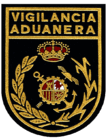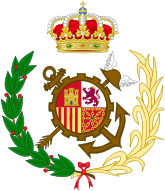Customs Surveillance Service
| Customs Surveillance Service Servicio de Vigilancia Aduanera | |
|---|---|
| Common name | ADUANAS / CUSTOMS |
| Abbreviation | SVA also DAVA |
|
Patch of the Spanish Customs Service | |
|
Badge of the Spanish Customs Service | |
|
Flag of the Spanish Customs Service with the double crowned H, symbol of the Spanish Royal Treasury | |
| Motto |
Por tierra, mar y aire Through land, sea and air |
| Agency overview | |
| Formed | Reorganized on February 12, 1982, since the 16th century |
| Preceding agencies |
|
| Employees | 2,000 |
| Legal personality | Governmental: Government agency |
| Jurisdictional structure | |
| National agency | Spain |
| Governing body | Government of Spain |
| Constituting instruments |
|
| General nature |
|
| Specialist jurisdictions |
|
| Operational structure | |
| Overviewed by | Deputy Directorate of Customs Surveillance |
| Headquarters | Madrid, Spain |
| Minister responsible | Cristóbal Montoro[1], Minister of Finance and Public Administrations |
| Agency executive | María Vicenta Abad Carrasco, Director-General |
| Parent agency | Agencia Tributaria |
| Website | |
| http://www.aeat.es | |
The Customs Surveillance Service (Spanish: Servicio de Vigilancia Aduanera, SVA) is a Spanish law enforcement agency responsible for the investigation and prosecution of cases involving contraband, illegal drugs, financial evasion and violations, money laundering, surveillance for financial police purposes and the provision of judicial police services.
History
Origins
The origin of the service goes back to the creation of a paramilitary organization (called in Spanish Resguardo) to protect the monopoly of tobacco of the Tabacalera (the oldest tobacco company in the world), a Spanish tobacco monopoly which was established in 1636. The primary duty of the Resguardo was to protect the monopoly that the State exercised over the tobacco, combatting smuggling since its trade was one of the primary sources of funds of the Spanish Royal Treasury between the seventeenth and the 18th centuries.[2]
Recent history
Recent history of the service begins in 1944 with the creation of the Servicio Especial de Vigilancia Marítima y Terrestre de Tabacalera S.A. (Special Service of Maritime and Terrestrial Surveillance from Tabacalera) charged of preventing the tobacco contraband. In 1954 due to the ineffectiveness of the service its duties were assumed by the Spanish Treasury who reorganized the service and created the Servicio Especial de Vigilancia Fiscal (Special Service of Fiscal Surveillance), made up of military and civilian personnel, which assumed the task of fighting the contraband. In 1982 the service was reorganized under the Servicio de Vigilancia Aduanera (Customs Surveillance Service) and its duties were broadened to include the investigation of economic crimes and the fight against illegal drugs, among other roles.[3]
Activities
The most common duties of the SVA are regulated by the Royal Decree 319/1982 and the Organic Law against contraband 12/1995.[4]
Those are the investigation, discovery and prosecution of contraband violations throughout the nation, territorial waters and airspace. The force also has powers conferred by the Spanish internal revenue agency (Agencia Tributaria) regarding economic crimes, including the fight against corruption, fraud investigation in foreign trade and money laundering, among other roles. [5]
The SVA cooperates with international and European organizations such as the European Anti-Fraud Office, Europol or the World Customs Organization.[6]
Organisation
Central Services
The Deputy Directorate of Customs Surveillance (Spanish: Dirección Adjunta de Vigilancia Aduanera, DAVA) is integrated into the Department of Customs and Special Taxes (Spanish: Departamento de Aduanas e Impuestos Especiales) of the Internal Revenue Agency (Spanish: Agencia Tributaria) of the Ministry of Economy and Finance.[7]
The customs headquarters is in Madrid.
Department of Customs and Special Taxes
- Deputy Directorate of Customs Surveillance
- Section of Operations (Subdirección General de Operaciones)
- Section of Logistics (Subdirección General de Logística)
- Section of Planning, Statistics and Coordination (Subdirección General de Planificación, Estadística y Coordinación)
- Section of Customs Management (Subdirección General de Gestión Aduanera)
- Section of Management and Control of Special Taxes (Subdirección General de Gestión e Intervención de Impuestos Especiales)
- Section of Inspection and Investigation (Subdirección General de Inspección e Investigación)
- Section of Chemicals and Technologies (Subdirección General Químico-Tecnológica)
- Section of International Relations (Subdirección General de Relaciones Internacionales)
Territorial Services
Regional Operations Area
- Operations Units
- Maritime Bases
- Air Bases
Armament and equipment
Air
The aircraft fleet consists of CASA C-212 Aviocar maritime patrol aircraft[8] and MBB Bo 105, Dauphin and BK117 helicopters manufactured by Eurocopter.[9]
Maritime
The maritime component of the Customs Surveillance Service is one of the largest employed by the Spanish Government with approximately 90[10] vessels in service. The maritime units of the service are classed as Spanish Navy Auxiliary vessels (Decree 1002/1961, of maritime surveillance).[11]
- Special Operations ships: 2 Ships for Special Operations and counterdrug patrols. These ships have both a medium helicopter deck, Long Range Interceptors and Deployable Pursuit Boats (DPB), detention cells, etc.
- High Endurance ships: 18 of different classes. Equipped with Deployable Pursuit Boats.
- Medium Endurance ships and High Speed Interception boats: 24 different classes. Depending of which class they are they carry Deployable Pursuit Boats.
- Others, including Rigid Inflatable Boats, boats seized from smugglers and used by the service, etc.[12]
Maritime Special Operations Units
The Special Operations Units of the Customs Maritime Service are responsible for tracking drug shipments from foreign points-of-origin and interdicting them in international waters, supported by the investigations of ground staff.
Ground forces
Most of the vehicles used are unmarked while some of them are marked, specially those deployed in airports and seaports or in specific operations. They also are equipped with mobile scanners for non-intrusive inspections. Investigation units have special equipment to accomplish their missions like thermal cameras, interceptions devices, etc.[13]
Small Arms
Spanish Customs Agents are armed with the 9mm Heckler & Koch USP Compact pistols and Heckler & Koch MP5 submachine guns. Also 7.62mm MG3 and .50 caliber M2 machine guns are mounted on vessels.
Gallery
-
SVA Fulmar class ship for counterdrug special operations
-
Alcaraván class patrol ship Alcaraván IV
-
Cormorán class (Rodman-55HJ) High Speed Interception boat Águila I
-
Gerifalte class (Rodman-101) patrol ship Arao
-
HJ class High Speed Interception boat HJ-VII
-
Alcotán class High Speed Interception boat Fénix
-
Gerifalte class patrol ship Alca
-
2 SVA patrol vessels in Cartagena Naval Base
See also
References
- ↑ "Cristóbal Montoro, Ministro de Hacienda y Administraciones Públicas" [Cristobal Montoro Minister of Finance and Public Administrations] (PDF) (in Spanish). Spanish Official Gazette. 2011-12-22.
- ↑ Carlos E. Corona, José A. Armillas Vicente (1984). La España de las reformas: Hasta el final del reinado de Carlos IV. Ediciones Rialp. pp. 207–209. ISBN 978-84-321-2106-7.
- ↑ "History of the Spanish Customs".
- ↑ "Organic Law against contraband 12/1995".
- ↑ "Royal Decree 319/1982".
- ↑ "OLAF Anti-Fraud Communicators Network".
- ↑ "Central Services organisation of the Department of Customs and Special Taxes".
- ↑ "C-212 aircraft of the SVA".
- ↑ "Spanish Customs helicopters".
- ↑ "Spanish Customs Equipment".
- ↑ "Lista de Buques Auxiliares de la Armada Española - SVA ships". Retrieved 2009-05-14.
- ↑ Rush, Neill. "SVA equipment". Retrieved 2009-05-14.
- ↑ "Spanish Customs ground forces". Retrieved 2009-05-14.
External links
- Official web site of the Spanish internal revenue agency (Agencia Tributaria)
- Official EU web site dedicated to the European Customs
- Naval World On-Line web Customs Surveillance Service equipment (In English)


